Bios 242 week 1 lab Study guides, Class notes & Summaries
Looking for the best study guides, study notes and summaries about Bios 242 week 1 lab? On this page you'll find 138 study documents about Bios 242 week 1 lab.
Page 3 out of 138 results
Sort by
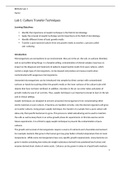
-
BIOS 242 Week 1 Lab 1; Culture Transfer Techniques
- Other • 9 pages • 2023
- Available in package deal
-
- $20.49
- + learn more
Lab 1: Culture Transfer Techniques Learning Objectives: • Identify the importance of aseptic technique in the field of microbiology • Apply the concept of aseptic technique and its importance in the field of microbiology. • Identify different forms of basic growth media • Transfer a pure bacterial culture from one growth media to another, a process called sub- culturing. Introduction: Materials: Nutrient broth, Nutrient agar slants, Nutrient agar stabs, liquid and slant culture...
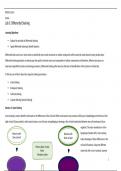
-
BIOS 242 Week 3 Assignment; Lab 5 of 14 Onsite; Differential Staining
- Other • 18 pages • 2024
-
- $9.99
- + learn more
BIOS 242 Week 3 Assignment; Lab 5 of 14 Onsite; Differential Staining Learning Objectives: Explain the principle of differential staining Apply differential staining to identify bacteria Differential stain uses two or more stains to specifically stain certain structures or cellular components which cannot be easily observed using simple stains. Differential staining principles are based upon the specific chemical nature and composition of cellular components and therefore, different s...
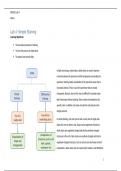
-
BIOS 242 Week 2 Assignment; Lab 4 of 14 Onsite; Simple Staining
- Other • 15 pages • 2024
-
- $9.99
- + learn more
BIOS 242 Week 2 Assignment; Lab 4 of 14 Onsite; Simple Staining Lab 4: Simple Staining Learning Objectives: To learn about principle of staining To learn the process of simple stain To prepare wet mount slides In light microscopy, colored dyes, called stains are used to improve contrast between the specimen and the background surrounding the specimen. Staining makes visualization of the specimen easier due to increased contrast. This is crucial for specimens that are mostl...
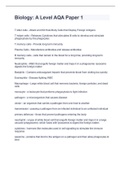
-
Bios 255 Final exam review with complete solution with complete solution/A+ Graded
- Package deal • 7 items • 2024
-
- $19.99
- + learn more
Bios 255 Final exam review with complete solution BIOS 314 Exam 1 (Lab Safety and Microscopy-Environmental Stresses) with complete solution ATI Comprehensive Test B Week 1 - BIOS 242 test with complete solution BIOS 1300 lab exam 1 Ohio University with complete solution
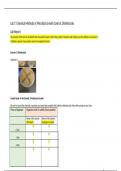
-
BIOS 242 Week 4 Assignment; Lab 7 of 14 Onsite; Disinfectants and Antibiotics
- Other • 6 pages • 2024
-
- $9.49
- + learn more
BIOS 242 Week 4 Assignment; Lab 7 of 14 Onsite; Disinfectants and Antibiotics Lab Report: Disinfectants and Antibiotics Purpose: Describe the purpose of the lab. Exercise 1: Disinfectants Organism 1: Be sure to record the chemical or product you tested and complete this table by obtaining data from other groups in your class Organism 2: Be sure to record the chemical or product you tested and complete this table by obtaining data from other groups in your class Q...
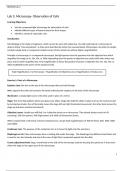
-
BIOS 242 Week 2 Assignment; Lab 3 of 14 Onsite; Microscopy Observation of Cells
- Other • 10 pages • 2024
-
- $9.99
- + learn more
BIOS 242 Week 2 Assignment; Lab 3 of 14 Onsite; Microscopy Observation of Cells Lab 3: Microscopy- Observation of Cells Learning Objectives: Use the compound light microscope for observation of cells. Identify different types of bacteria based on their shapes. Identify a variety of eukaryotic cells. Introduction: Microbiology is the study of organisms, which cannot be seen with naked eye. You will need help of a microscope to observe these “tiny animalcules” as they w...
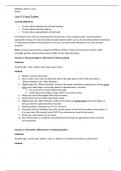
-
BIOS 242 Week 5 Assignment; Lab 9 of 14 Onsite; Food Safety.
- Other • 7 pages • 2024
-
- $9.99
- + learn more
BIOS 242 Week 5 Assignment; Lab 9 of 14 Onsite; Food Safety. Lab 9: Food Safety Learning Objectives: To learn about effectiveness of hand washing To learn about cleaning produce To learn about appropriately storing foods GI infections occur due to contaminated food and water. Clean drinking water, washed produce, appropriate storage of food and simple personal hygiene habits such as hand washing help tremendously in reducing the incident of GI infections. In this lab, we will test the ef...
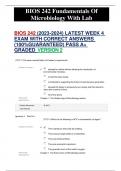
-
BIOS 242 (2023-2024) LATEST WEEK 4 EXAM WITH CORRECT ANSWERS (100%GUARANTEED) PASS A+ GRADED VERSION 2
- Exam (elaborations) • 17 pages • 2023
- Available in package deal
-
- $13.49
- + learn more
BIOS 242 () LATEST WEEK 4 EXAM WITH CORRECT ANSWERS (100%GUARANTEED) PASS A+ GRADED VERSION 2 Fundamentals Of Microbiology With Lab (TCO 1) The swan-necked flasks of Pasteur’s experiments
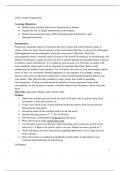
-
BIOS 242 Week 4 Assignment; Lab 8 of 14 Onsite; Fomite Transmission.
- Other • 2 pages • 2024
-
- $8.99
- + learn more
BIOS 242 Week 4 Assignment; Lab 8 of 14 Onsite; Fomite Transmission Learning Objectives: Define fomite and how bacteria are transferred via fomites. Explain the role of fomite transmission in the hospital. Define nosocomial infections, HAIs (hospital acquired infections), and Iatrogenic infections. Introduction: Materials: Agar plate, Marker, ruler, sterile swabs Method: Obtain one nutrient agar and divide the back of the plate into 8 sections using ruler and marker. Label ...
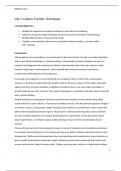
-
BIOS 242 Week 1 Assignment; Lab 1 of 14 Onsite - Culture Transfer Techniques
- Other • 9 pages • 2024
-
- $9.99
- + learn more
Lab 1: Culture Transfer Techniques Learning Objectives: Identify the importance of aseptic technique in the field of microbiology Apply the concept of aseptic technique and its importance in the field of microbiology. Identify different forms of basic growth media Transfer a pure bacterial culture from one growth media to another, a process called sub- culturing. Introduction: Microorganisms are everywhere in our environment; they are in the air, the soil, on surfaces (fomi...

How did he do that? By selling his study resources on Stuvia. Try it yourself! Discover all about earning on Stuvia


